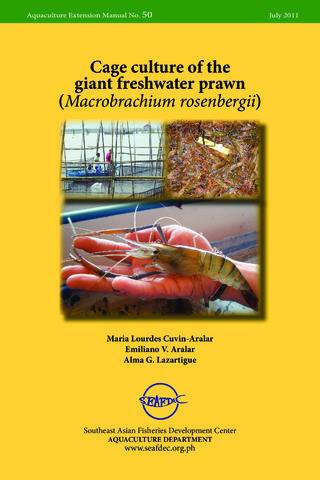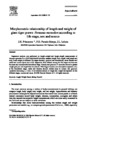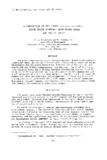| dc.contributor.author | Monghit-Camarin, Ma-Ann A. | |
| dc.contributor.author | Cruz-Lacierda, Erlinda R. | |
| dc.contributor.author | Pakingking, Rolando V., Jr. | |
| dc.contributor.author | Cuvin-Aralar, Maria Lourdes | |
| dc.contributor.author | Traifalgar, Rex Ferdinand | |
| dc.contributor.author | Añasco, Nathaniel C. | |
| dc.contributor.author | Austin, F. W. | |
| dc.contributor.author | Lawrence, M. L. | |
| dc.date.accessioned | 2020-10-02T03:14:54Z | |
| dc.date.available | 2020-10-02T03:14:54Z | |
| dc.date.issued | 2020-09-30 | |
| dc.identifier.citation | Monghit-Camarin, M.A., Cruz-Lacierda, E. R., Pakingking Jr., R., Cuvin-Aralar, M. L., Traifalgar, R. F., Añasco, N. C., ... & Lawrence, M. L. (2020). Bacterial microbiota of hatchery-reared freshwater prawn Macrobrachium rosenbergii (de Man, 1879). Asian Fisheries Science, 33(3), 241-248. | en |
| dc.identifier.issn | 0116-6514 | |
| dc.identifier.uri | http://hdl.handle.net/10862/6003 | |
| dc.description.abstract | Quantitative and qualitative analyses of bacterial microbiota associated with hatchery of freshwater prawn Macrobrachium rosenbergii (de Man, 1879) were conducted over three larval cycles, along with important water quality parameters. Physicochemical parameters (temperature, DO, salinity, pH and total ammonia) of culture water were within the optimum level required for the hatchery phase of M. rosenbergii. Aerobic plate count (APC) (log10 CFU.mL-1) ranged from 4.2 ± 0.18–8.7 ± 0.01 in rearing water and (log10 CFU.g-1) 3.3 ± 0.12–9.1 ± 1.1 in eggs and larvae. Significant differences in APCs among larval stages were observed. Ten genera and 17 species were identified with the predominance of Gram-negative bacteria constituting 63 % of all isolates (n = 706). Acinetobacter baumannii, Acinetobacter lwoffii, Chryseobacterium indologenes, Enterobacter aerogenes, Enterobacter cloacae, Vibrio furnissii, Vibrio cholerae non-01, Plesiomonas shigelloides, Pseudomonas aeruginosa, Pseudomonas pseudoalcaligenes, Bacillus cereus, Staphylococcus haemolyticus, Staphylococcus warneri and Staphylococcus xylosus were predominantly present in culture water. These bacteria likewise dominated in eggs and larvae except for the absence of Ps. aeruginosa, Ps. pseudoalcaligenes, V. cholerae non-01, Staphylococcus epidermidis and Staph. xylosus in eggs, clearly indicating that resident bacteria in water affect the composition of bacteria in eggs and larvae. Some of these are opportunistic pathogens. Thus, control measures to reduce influx of pathogenic microbes in the system by maintaining good water quality and good farm management practices through disinfection of culture facilities, rearing water, Artemia cysts, the practice of good hygiene of personnel, regular water exchange and feed regulation among others and cautionary use of antibiotics can be adopted. | en |
| dc.language.iso | en | en |
| dc.publisher | Asian Fisheries Society | en |
| dc.subject | quantitative analysis | en |
| dc.subject | qualitative analysis | en |
| dc.subject | Macrobrachium rosenbergii | en |
| dc.subject | prawns and shrimps | en |
| dc.subject | bacteriological analysis | en |
| dc.title | Bacterial microbiota of hatchery-reared freshwater prawn Macrobrachium rosenbergii (de Man, 1879) | en |
| dc.type | Article | en |
| dc.citation.volume | 33 | |
| dc.citation.issue | 3 | |
| dc.citation.spage | 241 | |
| dc.citation.epage | 248 | |
| dc.citation.journalTitle | Asian Fisheries Science | en |
| dc.subject.asfa | check lists | en |
| dc.subject.asfa | species composition | en |
| dc.subject.asfa | flora | en |
| dc.subject.asfa | pathogens | en |
| dc.subject.asfa | prawn culture | en |
| dc.subject.asfa | aquaculture | en |
| dc.subject.asfa | physicochemical properties | en |
| dc.subject.asfa | bacteriology | en |
| dc.subject.asfa | Bacteria | en |
| dc.identifier.essn | 2073-3720 | |
| dc.identifier.doi | 10.33997/j.afs.2020.33.3.005 | |



